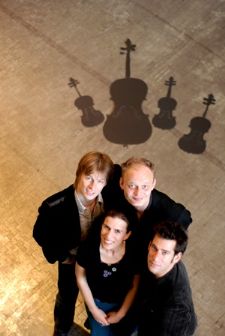|
Symphony
FROM THE NEW WORLD TO THE OLD WORLD
by Peter Lert
Saturday, June 14, 2025
Chamber
MC2 DUO RECITAL CLOSES 222'S SEASON
by Terry McNeill
Saturday, June 14, 2025
Choral and Vocal
CANTIAMO SONOMA'S LUSCIOUS A CAPELLA SINGING IN SEASON ENDING CONCERT
by Pamela Hicks Gailey
Sunday, June 8, 2025
Symphony
SRS SEASON ENDS WITH RESOUNDING TA-TA-TA-BANG
by Terry McNeill
Sunday, June 1, 2025
Symphony
YOUTHFUL VIRTUOSITY ON DISPLAY AT USO'S MAY CONCERTS
by Peter Lert
Saturday, May 17, 2025
Symphony
MYSTICAL PLANETS AND LIVELY GERSHWIN ORTIZ AT FINAL SRS CONCERT
by Peter Lert
Sunday, May 4, 2025
Symphony
VSO'S CONCERT MUSIC OF TIME, MUSIC OF PLACE
by Peter Lert
Sunday, April 27, 2025
VOCAL ELEGANCE AND FIRE AT THE 222'S RECITAL APRIL 26
by Pamela Hicks Gailey
Saturday, April 26, 2025
CANTIAMO SONOMA SINGS AN INSPIRED GOOD FRIDAY MOZART REQUIEM CONCERT
by Pamela Hicks Gailey
Friday, April 18, 2025
DRAMATIC SHOSTAKOVICH SYMPHONY CLOSES PHILHARMONIC'S 25TH SEASON
by Terry McNeill
Sunday, April 13, 2025
|
 |
 The Hugo Wolf Quartet |
VIENNESE LIFE, LOVE AND DEATH
by Steve Osborn
Monday, October 20, 2008
Shortly after taking the stage at the Occidental Community Church on Oct. 18, Gertrud Weinmeister, the violist of the Hugo Wolf Quartet, observed that Sonoma County resembles Vienna in its profusion of hillside vineyards. She further noted that all three composers on the Vienna-based ensemble’s program — Haydn, Schubert and Berg — were wine lovers.
Music and wine have a lot in common. Most fundamentally, both transform reality for a finite amount of time: music for as long the song endures; wine for as long as the inebriation lasts. Both are also made from a single core element (sounds or grapes) that the composer or winemaker picks, crushes, blends, bottles and otherwise transforms from raw material into finished product.
The quality and effect of that product depends on the skill of the composer or winemaker. For the ever-cheerful Haydn, his sonic intoxicant induces jollity and frolic. For the tortured Alban Berg, musical drinking leads to the depths of passion, betrayal and adultery. And for Schubert, a mere sip is the portal to another world, one far removed from the suffering of the present.
Back on stage, the music began with a pronounced intake of air, presumably from first violinist Sebastian Gürtler, as the quartet launched into Haydn’s sprightly Opus 33, No. 5. Taking full advantage of the church’s intimate acoustic, the quartet brought forth every individual line, with precisely controlled dynamics and a remarkable rhythmic flexibility. Rather than chaining themselves to a metronome, the group allowed each of Haydn’s long phrases to develop its own internal rhythm and meaning. The result was a fresh and captivating reading of a time-honored classic.
Gürtler invested the second movement, a Largo cantabile, with real drama by using minimal vibrato and allowing the other voices — violist Weinmeister, second violinist Régis Bringolf and cellist Florian Berner — to come through. Judging from the richness of tone, they all have superior instruments, and the sound they produced was almost sculptural in its solidity and strength. The last movement, a set of variations on a simple theme, allowed each instrument to shine in turn, ending with a fiery Presto replete with tricky bowing.
The festive country dances evoked in the Haydn find their counterpart in the elegiac waltzes of Berg’s “Lyric Suite,” which tells the true story of the married composer’s doomed affair with the wife of a wealthy businessman. The tempo markings of the suite’s six movements offer more than enough evidence of the affair’s inexorable progression from joviality (Allegro gioviale), to love (Andante amoroso), to mystery (Allegro mysterioso), to passion (Adagio appassionato), to delirium (Presto delirando), to final desolation (Largo desolato).
To evoke these various emotive states, Berg uses almost every variety of sound available to the string quartet, along with many varieties of his own invention. The academics may speak of Berg’s 12-tone rows and precisely calibrated metronome markings, but the emotional impact of this powerful work is mainly conveyed by the quality of its sound, from shimmering pianissimo tremolos to thunderous chordal sforzandos.
The Hugo Wolf proved masters at keeping up with Berg’s constantly shifting sonic landscape. Their bows were all over their instruments, whether digging in near the bridge or feathering across the fingerboard. The third movement, with its hushed beginning and onrushing pizzicatos, was particularly remarkable. On the down side, some parts of the suite seemed simply too loud. The effect of maximum volume can be dramatic, but it’s difficult to sustain. A little more mezzo forte would have been in order.
In contrast, excessive volume was never an issue in the concluding work, Schubert’s majestic “Death and the Maiden.” From the ringing chords at the beginning to the furious presto at the end, the Hugo Wolf played this masterpiece to perfection. Their dynamics, tempi and interpretation were squarely aligned.
Each movement brought new insight and depth of feeling. The first was a model of sustained energy; the second of delicate poignancy. The heartfelt variations in the latter movement showed off each player’s impeccable intonation and intelligent phrasing. By the end of the movement, the original melody had floated away on a heavenly cloud. In the Scherzo and Trio of the third movement, the players really dug in with their bows, allowing each note to ring out.
But the fourth movement Presto was the real standout. From the onset, all four players launched into a furious dance, led by the stern-faced Gürtler, whose expression was unvarying. Each note was distinct, the runs not a blur of sound but a sequence of sharply etched intervals. The syncopations drove the rhythms, which became increasingly wild and thrilling.
It was a memorable performance, a reminder that Vienna is still the musical capital, its composers and performers still intoxicated with sound.
|

